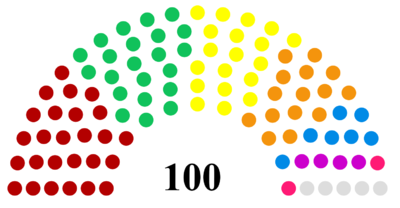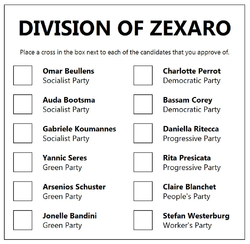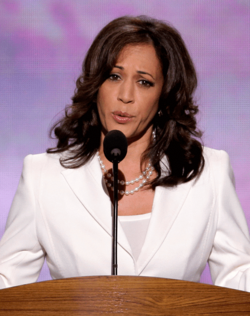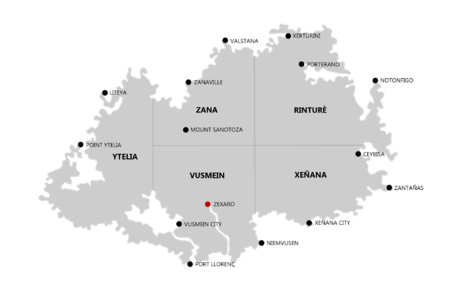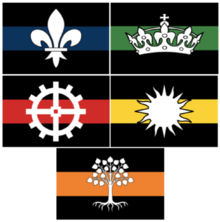Difference between revisions of "Nation/Llorens"
m |
|||
| Line 54: | Line 54: | ||
===Expansion=== | ===Expansion=== | ||
| − | Captain Vusmein Llorens and his crew of sailors discovered the uninhabited island on 5 May 2016, later to be known as Llorens, after presumably escaping from conflict in an unknown land. Llorens went through a rapid establishment period, as there was no resistance or prior inhabitants. The state capital establishments were Zexaro on 6 May 2016, Xeñana City on | + | Captain Vusmein Llorens and his crew of sailors discovered the uninhabited island on 5 May 2016, later to be known as Llorens, after presumably escaping from conflict in an unknown land. Llorens went through a rapid establishment period, as there was no resistance or prior inhabitants. The state capital establishments were Zexaro on 6 May 2016, Xeñana City on 16 May 2016, Liteya on 26 May 2016, Zanaville on 5 June 2016, and Xerturini on 15 June 2016. |
===Unification=== | ===Unification=== | ||
| Line 62: | Line 62: | ||
* The capital will be Zexaro, Vusmein | * The capital will be Zexaro, Vusmein | ||
* Annual democratic elections will be held to elect a Parliament, President & Vice-President | * Annual democratic elections will be held to elect a Parliament, President & Vice-President | ||
| − | |||
| − | |||
| − | |||
| − | |||
| − | |||
| − | |||
==Government== | ==Government== | ||
Revision as of 03:22, 28 August 2016
Federal Republic of Llorens
|
|||||
|---|---|---|---|---|---|
|
|||||
| Motto: People first! | |||||
Map of Llorens
|
|||||
| Region | The Leftist Assembly | ||||
| Capital and largest city | Zexaro | ||||
| Official languages | English | ||||
| Demonym | Llorenian | ||||
| Government | Federal republic | ||||
| - | President | Elisabeth Harland | |||
| - | Vice-President | Josef Cervenka | |||
| Legislature | Unicameral (Parliament) | ||||
| History | |||||
| - | Discovery | May 5, 2016 | |||
| - | Unification of Llorens | June 11, 2016 | |||
| - | First election | June 24, 2016 | |||
| Area | |||||
| - | Total | 7,038,164 km2 2,717,450 sq mi |
|||
| Population | |||||
| - | 2016 estimate | 618,000,000 | |||
| GDP (PPP) | 2016 estimate | ||||
| - | Total | $55.5 trillion | |||
| - | Per capita | $89,758 | |||
| Gini (2016) | 19.83 low |
||||
| HDI (2016) | 0.7206 high |
||||
| Currency | Llorenç | ||||
| Drives on the | left | ||||
| ISO 3166 code | LLO | ||||
| Internet TLD | .tla | ||||
The Federal Republic of Llorens, more commonly known as Llorens, is a federal republic consisting of five states, Vusmein, Ytelia, Xeñana, Rinturè, and Zana. The country is situated in the region of The Leftist Assembly. The country was first discovered by Captain Vusmein Llorens on May 5, 2016. The nation is notable for having high political freedoms and civil rights, and non-existent economic freedoms. Llorens is a notably safe and pacifist nation, with compassionate and nice citizens, a very large welfare program, high foreign aid spending, and a high employment rate of 82.05%. The nation is an active member of the World Assembly. Llorens' national animal is the Lioness, which is a prosperous endemic species commonly found in the nation's abundant forests.
The Parliament of Llorens is held in Zexaro, the capital city, and is currently lead by the Socialist Party and it's leader, Elisabeth Harland, who is consequently the President of Llorens. The system is unicameral, consisting of the Parliament, and has 100 seats. An election is held in June every year, with 5 representatives elected to each district. The most recent election was the Llorenian federal election, 2016.
Contents
History
Expansion
Captain Vusmein Llorens and his crew of sailors discovered the uninhabited island on 5 May 2016, later to be known as Llorens, after presumably escaping from conflict in an unknown land. Llorens went through a rapid establishment period, as there was no resistance or prior inhabitants. The state capital establishments were Zexaro on 6 May 2016, Xeñana City on 16 May 2016, Liteya on 26 May 2016, Zanaville on 5 June 2016, and Xerturini on 15 June 2016.
Unification
The Unification of Llorens was a document created and established on June 11, 2016. It acts as a sort of constitution for the country to this day. The document briefly outlines new guidelines for the unification of the newly discovered island/continent to be named Llorens:
- The island/continent of no-name will be named Llorens and all its land will be unified into this one nation
- Llorens will be split into 5 states: Vusmein, Ytelia, Xeñana, Rinturè, and Zana.
- The capital will be Zexaro, Vusmein
- Annual democratic elections will be held to elect a Parliament, President & Vice-President
Government
Llorens runs under an unicameral political system, with Parliament being the sole parliamentary house. It consists of 100 seats and is held in the capital, Zexaro. The office of the President of Llorens is currently held by Elisabeth Harland, leader of the Socialist Party. The office of the Vice-President of Llorens is currently held by Josef Cervenka, leader of the Green Party.
Political Parties
There are 7 political parties that have seats in Parliament, in addition to five independents:
| Party | Leader | Seats | |
|---|---|---|---|
| Socialist Party | Elisabeth Harland | 26 | |
| Green Party | Josef Cervenka | 22 | |
| Progressive Party | Ludoviko Zabat | 19 | |
| Democratic Party | Amara Adriaansen | 15 | |
| Worker's Party | Stefan Westerburg | 7 | |
| People's Party | Alberta Bertolini | 4 | |
| National Party | Dorriane Kuiper | 2 | |
| Independents | - | 5 | |
Elections
Elections are held each year, using the Sainte-Laguë method, to elect five representatives per each of the 20 districts to the Parliament of Llorens, resulting in 100 total members. Voting is voluntary for Llorenian citizens who are 16 years or older. Eligible voters cast their ballot on a single piece of paper displaying each of the parties and independents for their district. Voters fill in at least one box next to their preferred party or independent.
Each party may submit a maximum of five candidates per district, so that they have the possibility to gain each seat in that district. Parties with one or more candidate in a district must submit a voting order so that votes can be distributed accordingly. The party must also submit a voting order, so that voters for parties, rather than individual candidates, can have their votes distributed accordingly.
The leader of the party with the most seats in Parliament is elected President, and the leader of the party with the second-most seats in Parliament is elected Vice-President. If either the party with the most seats or second-most seats is tied, a President/Vice-President will be elected by a majority vote in Parliament (excluding members of the tied parties). If this vote is still tied, a national direct vote will select the relevant position.
Ministries
There are eight core ministries of Government in Llorens. Each of these ministries is headed by a minister (e.g. Minister of Health) and a vice-minister (e.g. Vice-Minister of Health). These 16 positions are covered by the main party, currently the Socialist Party, to form a Cabinet, along with the party leader. If there aren't enough members in the main party to cover these positions, this party can choose to form a coalition and offload certain ministries, or these will be given to the second main party of Parliament. The 8 ministries are:
- Ministry of Law
- Ministry of Environment
- Ministry of Health
- Ministry of Education
- Ministry of Culture
- Ministry of Foreign Affairs
- Ministry of Innovation
- Ministry of Social Services
The current Cabinet of the 1st Parliament is:
| Ministry | Minister | Vice-Minister |
|---|---|---|
| Party Leader | Elisabeth Harland | |
| Ministry of Law | Dianne Romanov | Aridai Devine |
| Ministry of Environment | Karolina Abel | Serafino Gerillo |
| Ministry of Health | Dominique Bernard | Viviane Stark |
| Ministry of Education | Adair Airaldi | Auda Bootsma |
| Ministry of Culture | Veselko Steuben | Elisaveta Bastori |
| Ministry of Foreign Affairs | Bartolomeu Berkowitz | Gabriel Koumannes |
| Ministry of Innovation | Silvio Stoyanov | Joanna Vasilev |
| Ministry of Social Services | Malina Jankovic | Anzhela Gouveia |
Proposed Laws
A proposed law may be submitted to the Llorens Law Commission by any member of Parliament, in which it will be reviewed and revised. If the proposed law passes the LLC with a majority vote, it will then be submitted to Parliament. For a proposed law to pass Parliament, it must receive over 50% of the vote (over 50 votes). Any member may choose to abstain from voting, but this doesn't affect the number of votes needed to pass the proposed law in question.
Geography
Llorens is a considerably large nation, with 7,038,164km2 of land. The Llorenian landmass is officially classified by the Llorens Geographical Association as a continent, country, and island. The highest point in Llorens is Mount Sanotoza, at a height of 7,741 metres above sea level. The lowest point is Porterano Trench in Rinturè Bay, at a depth of 8,258 metres below sea level.
The majority of the continent tends to experience a temperate climate with four seasons, while the south-eastern area around regional Xeñana tends to experience a desert-like arid climate. The country is home to three World Assembly Heritage listed sites, the Liteya Rainforest, Mount Sanotoza, and the Captain Falls.
States
| State | Capital | Symbol | |
|---|---|---|---|
| Vusmein | Zexaro | Crown | |
| Ytelia | Liteya | Sun | |
| Xeñana | Xeñana City | Wheel | |
| Zana | Zanaville | Tree | |
| Rinturè | Xerturini | Fleur-de-lis | |
| ||||||||||||||||||||||



